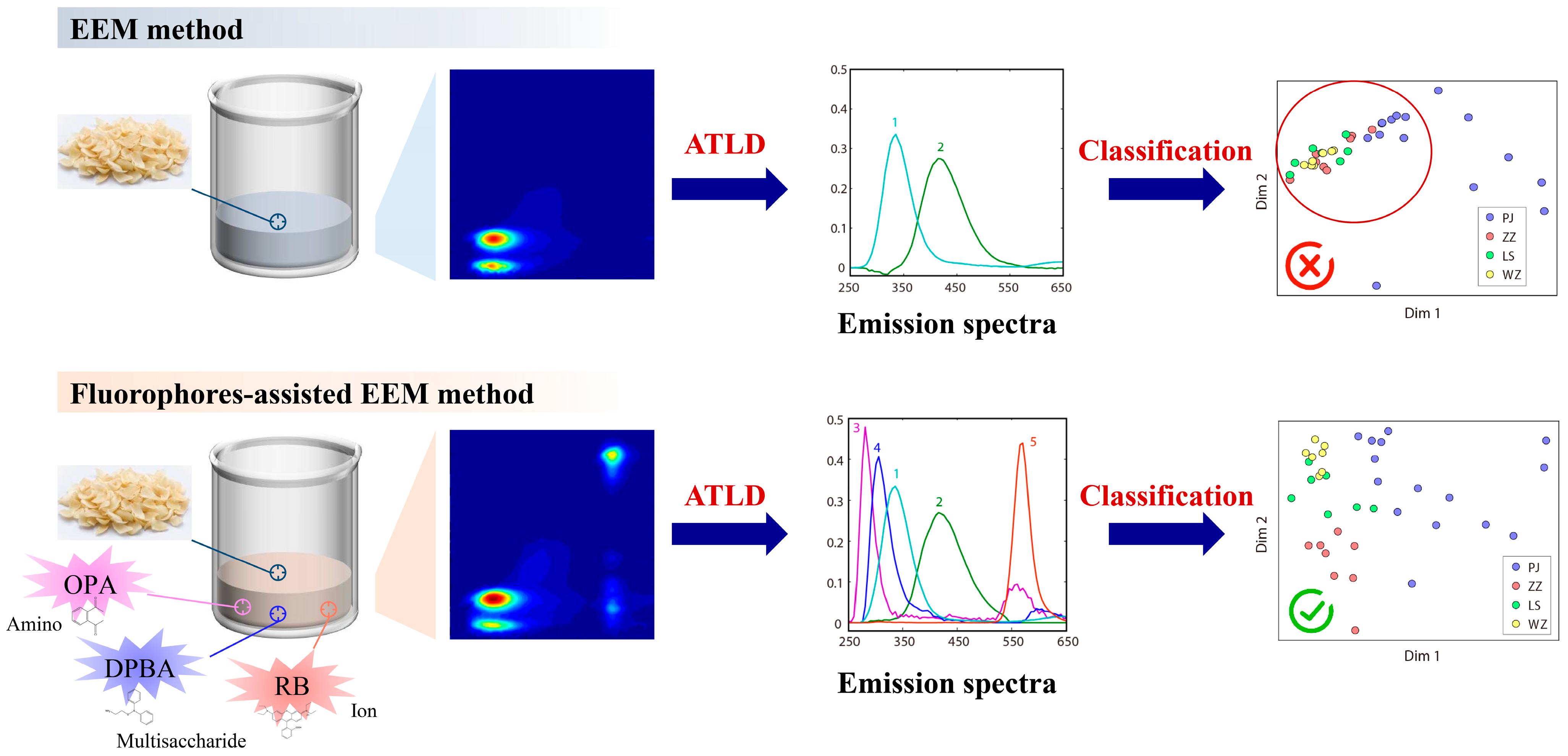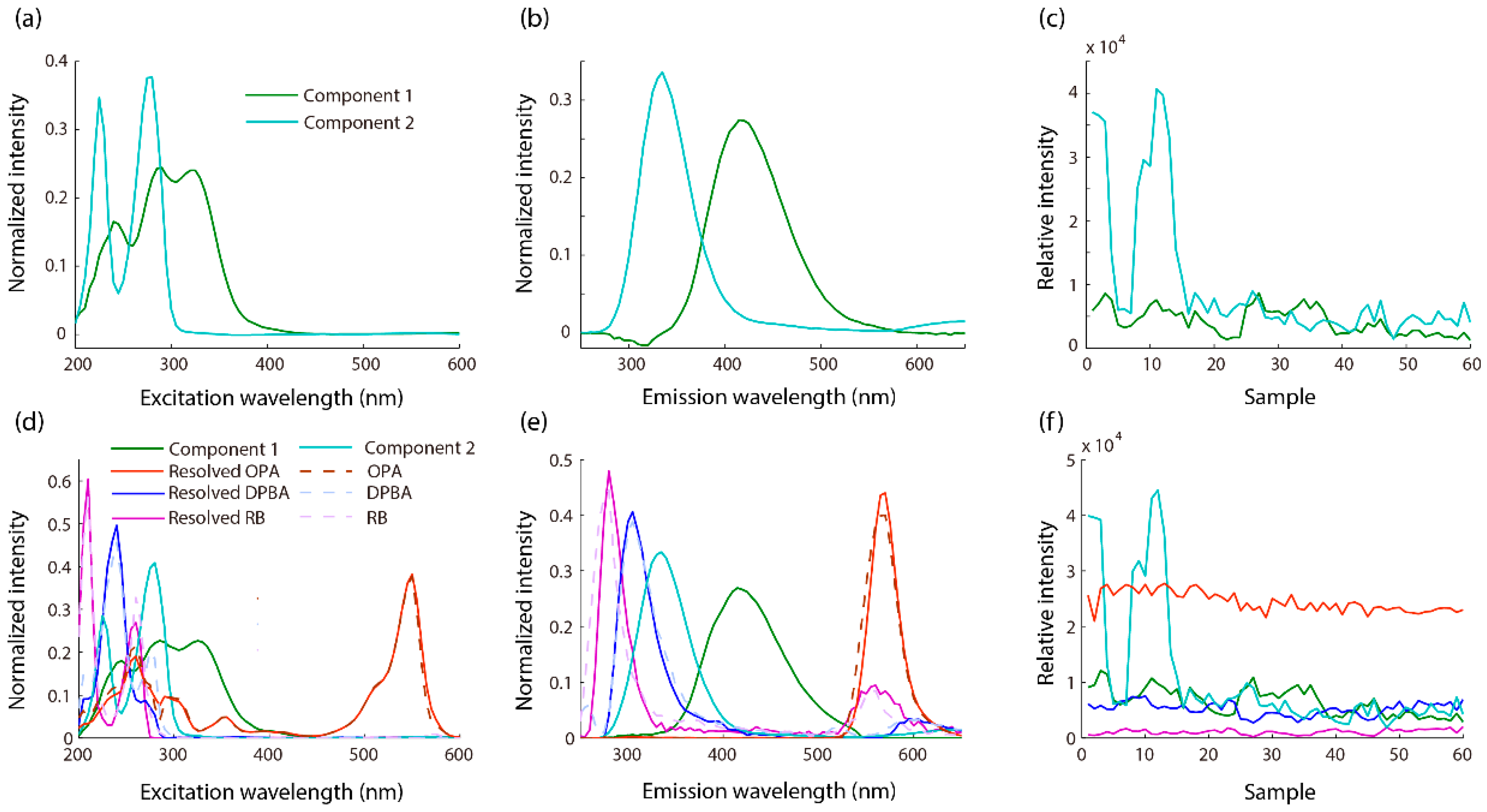Fluorophores-Assisted Excitation Emission Matrix Fluorescence Method for the Origin Traceability of Lily
Abstract
:1. Introduction
2. Materials and Methods
2.1. Sample Collection and Preparation
2.2. Chemicals and Reagents
2.3. Instrument, Software and Their Parameters
2.4. Theory
2.4.1. Trilinear Component Model
2.4.2. Alternating Quadrilinear Decomposition
3. Results and Discussion
3.1. Experiment Principle
3.2. Component Analysis and Origin Traceability of Lily
4. Conclusions
Supplementary Materials
Author Contributions
Funding
Institutional Review Board Statement
Informed Consent Statement
Data Availability Statement
Conflicts of Interest
References
- Pharmacopoeia, C. Commission. In Pharmacopoeia of the People’s Republic of China; China Medical Science Press: Beijing, China, 2010. [Google Scholar]
- Chau, C.F.; Wu, S.H. The development of regulations of Chinese herbal medicines for both medicinal and food uses. Trends Food Sci. Technol. 2006, 17, 313–323. [Google Scholar] [CrossRef]
- Hou, Y.; Jiang, J.G. Origin and concept of medicine food homology and its application in modern functional foods. Food Funct. 2013, 4, 1727–1741. [Google Scholar] [CrossRef]
- Wang, P.; Li, J.; Attia, F.A.K.; Kang, W.; Wei, J.; Liu, Z.; Li, C. A critical review on chemical constituents and pharmacological effects of Lilium. Food Sci. Hum. Wellness 2019, 8, 330–336. [Google Scholar] [CrossRef]
- Mimaki, Y.; Nakamura, O.; Sashida, Y.; Satomi, Y.; Nishino, A.; Nishino, H. Steroidal saponins from the bulbs of Lilium longiflorum and their antitumour-promoter activity. Phytochemistry 1994, 37, 227–232. [Google Scholar] [CrossRef] [PubMed]
- Nakamura, O.; Mimaki, Y.; Nishino, H.; Sashida, Y. Steroidal saponins from the bulbs of Lilium speciosum x L. nobilissimum ‘Star Gazer’and their antitumour-promoter activity. Phytochemistry 1994, 36, 463–467. [Google Scholar] [CrossRef]
- Zhou, J.; An, R.; Huang, X. Genus Lilium: A review on traditional uses, phytochemistry and pharmacology. J. Ethnopharmacol. 2021, 270, 113852. [Google Scholar] [CrossRef]
- Wang, H.Q.; Liu, H.T.; Wang, L.; Min, L.; Chen, B.; Li, H. Uncovering the active components, prospective targets, and molecular mechanism of Baihe Zhimu decoction for treating depression using network pharmacology-based analysis. J. Ethnopharmacol. 2021, 281, 114586. [Google Scholar] [CrossRef]
- Hui, H.; Li, X.; Jin, H.; Yang, X.; Xin, A.; Zhao, R.; Qin, B. Structural characterization, antioxidant and antibacterial activities of two heteropolysaccharides purified from the bulbs of Lilium davidii var. unicolor Cotton. Int. J. Biol. Macromol. 2019, 133, 306–315. [Google Scholar] [CrossRef]
- Rong, L.; Lei, J.; Wang, C. Collection and evaluation of the genus Lilium resources in Northeast China. Genet. Resour. Crop Evol. 2011, 58, 115–123. [Google Scholar] [CrossRef]
- Qin, K.; Fang, Q.; Cai, H.; Chen, Z.; Yang, G.; Cai, B. Analysis of chemical components in Baihe Zhimu Tang and its single herbs by high performance liquid chromatography-electrospray ionization-mass spectrometry. Chin. J. Anal. Chem. 2009, 37, 1759–1764. [Google Scholar]
- Restaino, O.F.; De Rosa, M.; Schiraldi, C. High-performance capillary electrophoresis to determine intact keratan sulfate and hyaluronic acid in animal origin chondroitin sulfate samples and food supplements. Electrophoresis 2020, 41, 1740–1748. [Google Scholar]
- Long, W.J.; Hu, Z.; Wei, L.; Chen, H.; Liu, T.; Wang, S.; Guan, Y.; Yang, X.; Yang, J.; Fu, H.Y. Accurate identification of the geographical origins of lily using near-infrared spectroscopy combined with carbon dot-tetramethoxyporphyrin nanocomposite and chemometrics. Spectrochim. Acta A 2022, 271, 120932. [Google Scholar] [CrossRef]
- Long, W.J.; Wang, S.; Hai, C.; Chen, H.; Gu, H.W.; Yin, X.L.; Yang, J.; Fu, H.Y. UHPLC-QTOF-MS-based untargeted metabolomics revealing the differential chemical constituents and its application on the geographical origins traceability of lily bulbs. J. Food Compos. Anal. 2023, 118, 105194. [Google Scholar] [CrossRef]
- Bian, Y.; Zheng, R.; Bayer, F.P.; Wong, C.; Chang, Y.C.; Meng, C.; Zolg, D.P.; Reinecke, M.; Zecha, J.; Wiechmann, S. Robust, reproducible and quantitative analysis of thousands of proteomes by micro-flow LC–MS/MS. Nat. Commun. 2020, 11, 157. [Google Scholar] [CrossRef] [PubMed] [Green Version]
- Ferreira, D.C.; Hernandes, K.C.; Nicolli, K.P.; Souza-Silva, É.A.; Manfroi, V.; Zini, C.A.; Welke, J.E. Development of a method for determination of target toxic carbonyl compounds in must and wine using HS-SPME-GC/MS-SIM after preliminary GC× GC/TOFMS analyses. Food Anal. Method. 2019, 12, 108–120. [Google Scholar] [CrossRef]
- Zhang, S.; Wang, H.; Zhu, M.J. A sensitive GC/MS detection method for analyzing microbial metabolites short chain fatty acids in fecal and serum samples. Talanta 2019, 196, 249–254. [Google Scholar] [CrossRef]
- Fang, H.; Wu, H.L.; Wang, T.; Long, W.J.; Chen, A.Q.; Ding, Y.J.; Yu, R.Q. Excitation-emission matrix fluorescence spectroscopy coupled with multi-way chemometric techniques for characterization and classification of Chinese lager beers. Food Chem. 2021, 342, 128235. [Google Scholar]
- Lenhardt, L.; Bro, R.; Zeković, I.; Dramićanin, T.; Dramićanin, M.D. Fluorescence spectroscopy coupled with PARAFAC and PLS DA for characterization and classification of honey. Food Chem. 2015, 175, 284–291. [Google Scholar] [CrossRef] [PubMed]
- Oh, S.K.; Yoo, S.H.; Pedrycz, W. Design of face recognition algorithm using PCA-LDA combined for hybrid data pre-processing and polynomial-based RBF neural networks: Design and its application. Expert Syst. Appl. 2013, 40, 1451–1466. [Google Scholar] [CrossRef]
- Fisher, R.A. The use of multiple measurements in taxonomic problems. Ann. Hum. Genet. 1936, 7, 179–188. [Google Scholar] [CrossRef]
- Wu, H.L.; Shibukawa, M.; Oguma, K. An alternating trilinear decomposition algorithm with application to calibration of HPLC–DAD for simultaneous determination of overlapped chlorinated aromatic hydrocarbons. J. Chemom. 1998, 12, 1–26. [Google Scholar] [CrossRef]
- Qing, X.D.; Zhou, H.B.; Zhang, X.H.; Wu, H.L.; Chen, C.Y.; Xu, S.W.; Li, S.S. Alternating trilinear decomposition of highly overlapped chromatograms for simultaneously targeted quantification of 15 PAHs in samples of pollution source. Microchem. J. 2019, 146, 742–752. [Google Scholar] [CrossRef]
- Arimori, S.; Bosch, L.I.; Ward, C.J.; James, T.D. A D-glucose selective fluorescent internal charge transfer (ICT) sensor. Tetrahedron Lett. 2002, 43, 911–913. [Google Scholar] [CrossRef]
- Wagner, B.D.; McManus, G.J. Enhancement of the fluorescence and stability of o-phthalaldehyde-derived isoindoles of amino acids using hydroxypropyl-β-cyclodextrin. Anal. Biochem. 2003, 317, 233–239. [Google Scholar]
- Elcoroaristizabal, S.; Callejón, R.M.; Amigo, J.M.; Ocaña-González, J.A.; Morales, M.L.; Ubeda, C. Fluorescence excitation–emission matrix spectroscopy as a tool for determining quality of sparkling wines. Food Chem. 2016, 206, 284–290. [Google Scholar] [CrossRef] [PubMed]
- Bahram, M.; Bro, R.; Stedmon, C.; Afkhami, A. Handling of Rayleigh and Raman scatter for PARAFAC modeling of fluorescence data using interpolation. J. Chemom. 2006, 20, 99–105. [Google Scholar] [CrossRef]
- del Ácido Protocatéquico, E.A.; y el Ácido Caféico, Á.F. Antioxidant effects of protocatechuic acid, ferulic acid, and caffeic acid in human neutrophils using a fluorescent substance. Int. J. Morphol. 2010, 28, 911–920. [Google Scholar]
- Wang, L.; Wu, H.L.; Yin, X.L.; Hu, Y.; Gu, H.W.; Yu, R.Q. Simultaneous determination of umbelliferone and scopoletin in Tibetan medicine Saussurea laniceps and traditional Chinese medicine Radix angelicae pubescentis using excitation-emission matrix fluorescence coupled with second-order calibration method. Spectrochim. Acta A 2017, 170, 104–110. [Google Scholar]
- Senanayake, S.N. Green tea extract: Chemistry, antioxidant properties and food applications—A review. J. Funct. Foods 2013, 5, 1529–1541. [Google Scholar] [CrossRef]




| Place of Origin | Variety | Sample Size |
|---|---|---|
| Pingjiang, Hunan province (PJ) a | Long Ya lily (annual) | 24 |
| Zhuzhou, Hunan Province. (ZZ) | Unknown | 13 |
| Longshan, Hunan Province. (LS) | Long Yu lily | 12 |
| Wanzai, Jiangxi Province. (WZ) | long Ya lily | 11 |
| Subgraph in Figure 2 | 280/330 nm | 225/330 nm | 335/425 nm | 260/565 nm | 550/565 nm |
|---|---|---|---|---|---|
| a | 4604 | 4503 | 364.2 | 113.1 | 3.055 |
| b | 311.9 | 572.4 | 33.72 | 79.44 | 3.850 |
| c | 99.97 | 187.8 | 56.85 | 157.2 | 3.202 |
| d | 97.41 | 155.1 | 37.99 | 1970 | 3475 |
| e | 5450 | 3810 | 564.6 | 2079 | 4192 |
| Method | PLS-DA | PCA-LDA | ||||||||
|---|---|---|---|---|---|---|---|---|---|---|
| LVs | CV | Training | Test | Pre | PCs | CV | Training | Test | Pre | |
| EEM | 1 | 59.5 | 67.6 | 71.4 | 66.7 | 1 | 48.7 | 56.8 | 50.0 | 66.7 |
| F-EEM | 4 | 94.6 | 97.3 | 92.9 | 100.0 | 4 | 89.2 | 94.6 | 92.9 | 88.9 |
| Model Validation | CCR (%) | Sensitivity a | Specificity b | ||||||
|---|---|---|---|---|---|---|---|---|---|
| PJ | ZZ | LS | WZ | PJ | ZZ | LS | WZ | ||
| Cross-validation | 94.6 | 93.3 | 100.0 | 85.7 | 100.0 | 100.0 | 96.6 | 100.0 | 96.7 |
| Training set | 97.3 | 100.0 | 100.0 | 85.7 | 100.0 | 100.0 | 100.0 | 100.0 | 96.7 |
| Test set | 92.9 | 100.0 | 100.0 | 66.7 | 100.0 | 100.0 | 100.0 | 100.0 | 90.9 |
| Train Set | TEST SET | ||||||||
|---|---|---|---|---|---|---|---|---|---|
| Predicted | Predicted | ||||||||
| PJ | ZZ | LS | WZ | PJ | ZZ | LS | WZ | ||
| Actual | PJ | 15 | 0 | 0 | 0 | 5 | 0 | 0 | 0 |
| ZZ | 0 | 8 | 0 | 0 | 0 | 3 | 0 | 0 | |
| LS | 0 | 0 | 6 | 1 | 0 | 0 | 2 | 1 | |
| WZ | 0 | 0 | 0 | 7 | 0 | 0 | 0 | 3 | |
Disclaimer/Publisher’s Note: The statements, opinions and data contained in all publications are solely those of the individual author(s) and contributor(s) and not of MDPI and/or the editor(s). MDPI and/or the editor(s) disclaim responsibility for any injury to people or property resulting from any ideas, methods, instructions or products referred to in the content. |
© 2023 by the authors. Licensee MDPI, Basel, Switzerland. This article is an open access article distributed under the terms and conditions of the Creative Commons Attribution (CC BY) license (https://creativecommons.org/licenses/by/4.0/).
Share and Cite
Fang, H.; Wu, H.; Wang, T.; Chen, Y.; Yu, R. Fluorophores-Assisted Excitation Emission Matrix Fluorescence Method for the Origin Traceability of Lily. Chemosensors 2023, 11, 426. https://doi.org/10.3390/chemosensors11080426
Fang H, Wu H, Wang T, Chen Y, Yu R. Fluorophores-Assisted Excitation Emission Matrix Fluorescence Method for the Origin Traceability of Lily. Chemosensors. 2023; 11(8):426. https://doi.org/10.3390/chemosensors11080426
Chicago/Turabian StyleFang, Huan, Hailong Wu, Tong Wang, Yao Chen, and Ruqin Yu. 2023. "Fluorophores-Assisted Excitation Emission Matrix Fluorescence Method for the Origin Traceability of Lily" Chemosensors 11, no. 8: 426. https://doi.org/10.3390/chemosensors11080426




